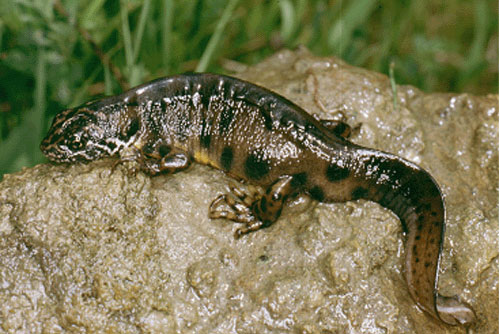Progetto Life - Provincia di Prato
Triturus Carnifex
- Common Name: Italian crested newt;
- Phylum: AMPHIBIANS;
- Class: AMPHIBIA;
- Order: CAUDATA;
- Family: Salamandridae;
Description and Recognition:
The largest newt species present in Italy. In fact, the female can grow up to 20 cm in total length, while the male usually doesn't exceed 15 cm; most of the specimens grow to between 10 and 15 cm. In both sexes, the colour of the dorsal areas ranges from a blackish-grey to olive-brown and blackish-brown, with various irregularly placed darker spots on the surface; the throat area is blackish or blackish-brown with whitish dots, while the belly area ranges from yellow to reddish-orange, with numerous blackish-brown or blackish spots, each very varied in shape, extension and position. The male, especially during the reproductive phase, has a noticeable barbed dorsal crest and, on each side of the tail, there is a whitish band, often tinged with blue and with pearly hues; as a rule, the female does not have a crest and, like the sub-adults, is characterized by a dorsal and supracaudal vertebral line, which varies in colour from light greenish-yellow to yellow and orangey-yellow. The larvae, which are yellowish or brown with marbling and darker spots on the top, are characterized by a tail that ends with a long filament and particularly long, thin fingers; when metamorphosis occurs, the larvae normally reach a total length of 5-8 cm, although exceptionally they can even exceed 10 cm.
Ecological notes:
Mating takes place in the water and is preceded by complex courting rituals for Alpine newts. During the breeding period, which usually takes place between the end of the winter and the beginning of the summer according to the altitude, it frequents small lakes, pools, ponds, watering troughs, fountains, canals, slow-flowing mountain streams, ditches, temporary pools of water, etc., both in wooded areas and in the open, where it may remain long after the breeding season; the females usually lay between 200 and 300 eggs. The land-based habitats are the same as those indicated for the Alpine newt. In the water, the adults feed on small and medium-sized aquatic invertebrates, sometimes including fish fry and amphibian eggs, larvae and young, including smaller specimens of their own species. Predators are generally the same as those for the previous species.
Distribution:
Based on biochemical research, the Italian crested newt is currently considered a separate species from the Triturus cristatus, to which, until some years ago, it was linked. Its area of distribution includes Southern Switzerland, the Alpine region of Austria, the Viennese forest, Western Slovenia, Istria and Italy, excluding the extreme Alpine areas and the islands; it has also been introduced in Southern Bavaria (see FRANZEN et al., 2002). In Italy, it is spread throughout most of the continental and peninsular territory, to south up to approximately the 39th parallel. In Tuscany, it can be observed throughout the regional territory, islands excluded, from sea level to above 1800 m on the Apennine chain.
Distribution in the Province of Prato:
The presence of this species has been confirmed in the hilly area of the central and southern parts of the territory in question, between 119 and 685 UTM grid squares, with recent observations in 6 out of 29 squares in the province, plus one with reference data; in total, the species has therefore been reported in 7 grid squares (24.1%), although it is presumably also present in other areas of the Province. It was not found in the plains, despite careful searches, and in the best case scenario appears to have become rare and very localised. Nonetheless, it was reported in the protected plains areas in the provinces of Florence and Pistoia right next to the boundaries with Prato Province.
Status and conservation:
In comparison with the past, the crested newt appears to be constantly decreasing in the territory of Prato, both from the point of view of its distribution and its population density, similarly to what is happening to some extent throughout its geographical area of distribution. The main threats it faces are the gradual destruction and alteration of its breeding grounds (in particular in peri-urban and industrialised areas), the introduction of carnivorous fish in hillside pools and lakes, the drainage of small water basins, the trampling of the ground in and around small pools by cattle and the number of newts killed by traffic during their spring migrations to the breeding grounds. Restoring and creating new habitats suitable for the species' life cycle appear to be the most effective ways to protect its conservation status. The Italian crested newt is listed in Annex II of the Bern Convention, Annexes B and D of the Habitat Directive and Annex A of the Tuscany Regional Law.
Photos:

centralino: 0574 5341 | info@provincia.prato.it | credits | note legali

